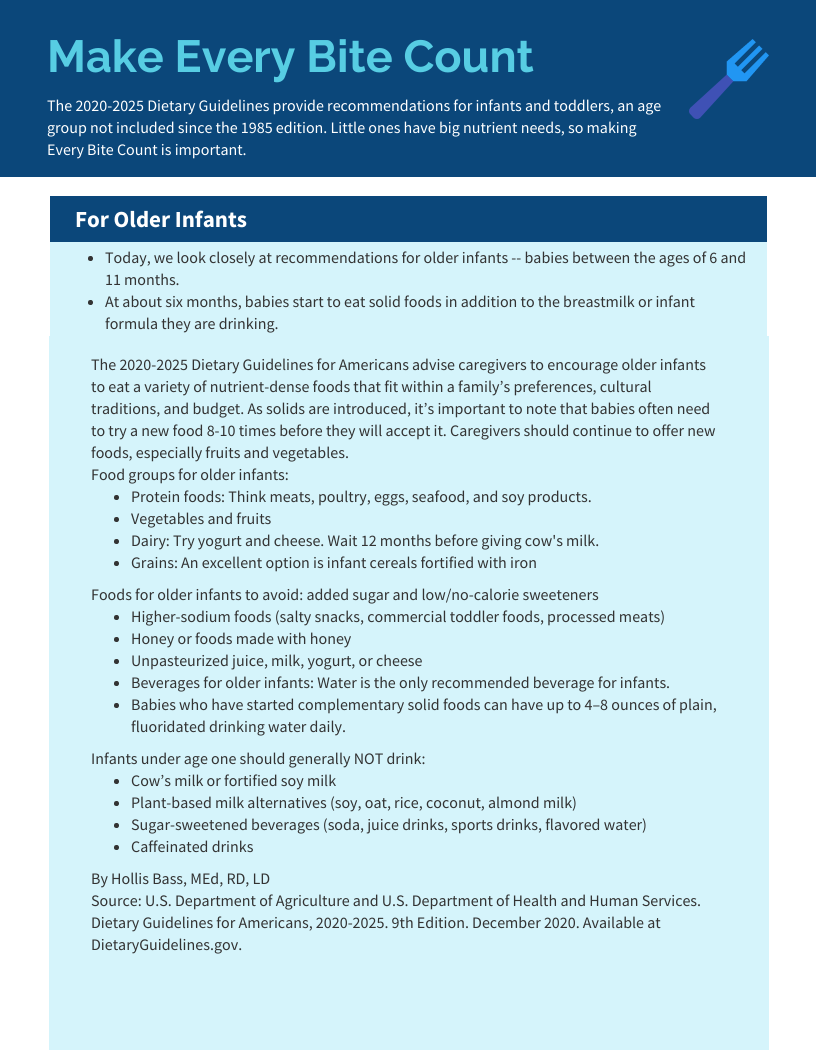Make Every Bite Count: Infants and Toddlers Part Two
The 2020-2025 Dietary Guidelines provide recommendations for infants and toddlers, an age group not included since the 1985 edition. Little ones have big nutrient needs, so making Every Bite Count is important.Here's part two of our new series by Hollis Bass, MEd, RD, LD
Key Recommendations – Birth to 23 months
Transition: As infants wean from breastmilk or formula, they transition to a healthy dietary pattern.
Is Baby Ready for Solids? At 4-6 months, infants develop the ability to safely eat and digest solid foods while continuing to breastfeed or drink infant formula. Look for these signs of readiness to try solid foods:
Baby can control his head and neck.
Baby sits up alone or with support.
Baby brings objects to her mouth.
Baby tries to grasp small objects, such as toys or food.
Baby swallows food rather than pushing it back out onto her chin.
About 32% of infants in the U.S. are introduced to complementary foods and beverages before 4 months. Infants drinking infant formula or a combination of breastmilk and formula are more likely to start solids too early.
Peanut Allergy? Infants with severe eczema and/or egg allergy are at high risk for peanut allergy. To reduce the risk of developing a peanut allergy, age-appropriate peanut-containing foods should be introduced at 4-6 months. However, the baby’s healthcare provider may recommend a blood test or skin prick to determine whether and how peanuts should be introduced, so check with them first.
Responsive Feeding: How we feed young children is as important as what we feed them. In addition to repeatedly offering new foods, the “how” includes recognizing and responding to a baby’s hunger and fullness cues. Infants (0–5 months): Signs of hunger:
Infant puts hands to mouth.
Infant turns head toward breast or bottle.
Infant puckers, smacks, or licks lips.
Infant has clenched hands.
Infants (0–5 months): Signs of fullness:
Infant closes mouth.
Infant turns head away from breast or bottle.
Infant relaxes hands.
Older Infants & Toddlers (6–23 months): Signs of hunger:
Baby reaches for or points to food.
Baby opens his mouth when offered a spoon or food.
Baby gets excited when she sees food.
Baby uses hand motions or makes sounds to let you know he is still hungry.
Older Infants & Toddlers (6–23 months): Signs of fullness:
Baby pushes food away.
Baby closes her mouth when food is offered.
Baby turns his head away from food.
Baby uses hand motions or makes sounds to let you know she is still full.
Vitamin B12: Breastfeeding mothers who do not consume adequate vitamin B12 (sometimes the case when following a vegan diet) should consult a healthcare professional about supplemental B12 for mom and/or baby.
Healthy Food Access for Infants & Toddlers: Fourteen percent of families with children experience food insecurity. These government nutrition programs can help support a healthy dietary pattern for infants and toddlers living in households with limited incomes:
By Hollis Bass, MEd, RD, LD
Source: U.S. Department of Agriculture and U.S. Department of Health and Human Services. Dietary Guidelines for Americans, 2020-2025. 9th Edition. December 2020. Available at DietaryGuidelines.gov.Did you miss Part One? We've got you covered!
Make Every Bite Count: Infants and Toddlers Part One is here!
Click the image to download a handout.



